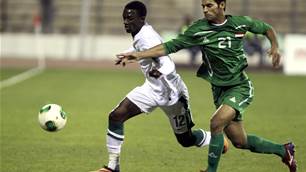The Asian Cup has travelled the length and breadth of the world’s largest continent making it the most wide open of competitions.
History of the Asian CupBack in 1956, TV was revolutionising the world of entertainment, Elvis Presley lead a rock ‘n’ roll revolution and a young Brazilian named Pelé was about to put his regal stamp on the world of football.
That year, a football revolution swept through Asia with the first ever Asian Cup tournament. Now, 51 years later, it’s the region’s biggest single sport extravaganza.
Superstars such as Japan’s “King” Kazu, China’s Jia Xiuquan, Khodadad Azizi of Iran and Shunsuke Nakamura have shown the world the potential of Asian footy.
It’s been controversial, too. Chinese fans burned Japanese flags as an estimated 5000 police lined the streets following the China-hosted final in 2004, won 3-1 by Japan.
Through the history of the Cup, various Asian football regions have dominated, making it arguably more open than the World Cup. The 1956 and 1960 tournaments were dominated by East Asian powerhouse South Korea with Israel a major contender. Fast forward to the ’80s and the Cup was dominated by West Asian nations Kuwait and Saudi Arabia following a stellar run of three consecutive wins by Iran.
By the ’90s and the new millennium, one East Asian nation had stamped its authority on the Cup with three victories: Japan.
It’s worth noting that hosting the tournament has been a decisive advantage. Six of the 13 Asian Cups have been won by the side with the home advantage.
The early years
With the World Cup born in 1930, it was only logical that a continental tournament would follow in Asia. Just two years after the formation of the Asian Football Confederation (AFC) in 1954, the first Asian Cup kicked off in Hong Kong. It featured seven of the 12 affiliated national associations in a round-robin format. The South Koreans took it out with surprise packet Israel finishing second.
The South Koreans had qualified for the World Cup two years earlier, and the Asian Cup has become an accurate barometer for World Cup success. South Koreans and Israelis (now in the European zone) dominated the first three Asian Cups. In 1960 South Korea reduced Israel to bridesmaids for a second time, winning 3-0 at home in Seoul. But with on home soil in 1964 they finally got their hands on the trophy, beating surprise packet India.
Iranian supremacy
Over the next few years Teheran wrested power away from East Asia. The 1968 Asian Cup hosted by Iran was the last time the Cup was played on a round-robin basis. The home team took out its first trophy, with Burma a surprise runner-up.
In Thailand in 1972, an extra time 2-1 win in the first ever knockout format saw the reigning holders overcome South Korea, Hussain Khalani with the decisive goal.
Iran stepped in to stage the Cup for a second time in 1976, after Lebanon was forced to withdraw as host. The host took the Cup for a third time with a 1-0 victory over Kuwait, thanks to a Ali Parvin goal.
By now, other cashed up Arab nations were planning their own dominance.
West Asian ascendancy
With petro-dollars fuelling their football ambitions, Kuwait brought in Brazilian coaches such as Mario Zagallo. It was no surprise that it took out the 1980 Asian Cup as hosts, the Arab side handing South Korea a 3-0 football lesson in the final. Kuwaiti football was indeed on the boil, culminating in an appearance at World Cup 82 Spain.
Singapore hosted one of the most nail-biting Cups in 1984. In the semi-finals, the Saudis prevailed 6-5 in a penalty shoot-out over Iran, while Li Huayun’s extra-time winner gave the Chinese a 1-0 win over Kuwait. Saudi Arabia then took the title with a 2-0 win over China in the final. Shaye Al Nafisah opened the scoring before the majestic Majed Abdullah sealed victory.
Just to prove this was no fluke, Saudi Arabia became the third nation to achieve back-to-back Asian Cup victories in 1988. For the first time the final went to penalties with the Saudis holding edging out Qatar.
No-one was talking about Japan at this stage. They looked out of their depth with just one point in the Cup of 1988. However, their golden days were about to arrive.
Turning Japanese
A club football revolution in Japan would provide a powerful national team. Hosting also helped as King Kazu Miura’s men.
Japan’s semi-final with China has gone down as one of the best in history. Masashi Nakayama struck the winner with six minutes left to give the Japanese a 3-2 win. In the final, Takuya Takagi’s early strike in the final saw Japan beat Saudi Arabia 1-0.
The next Cup saw a blip in the Japanese domination, with 1996 instead remembered for Ali Daei’s four goals in the final 25 minutes over a 6-2 Iranian victory over South Korea. The final between Saudi Arabia and UAE finished goalless with the Saudis getting up 4-2 in the shoot-out.
Millennium men
Japan returned with a vengeance, winning the next two tournaments. In 2000, Lebanon hosted but South Korea staged the comeback of the tournament against Iran, equalising in the final minute through Kim Sang-Sik before Lee Dong-Gook grabbed the winner in extra-time. China, South Korea and Japan all reached the semis. Shigeyoshi Mochizuki’s 29th minute strike proved to be the only goal of the final as Japan triumphed 1-0 victory over Saudi Arabia.
And so to Asian Cup 2004. In the early stages, emerging Uzbekistan topped their group after winning against Iraq, Saudi Arabia and Turkmenistan (whose Begenchmuhammed Kuliyev provided a challenge for those putting the players’ names on the shirts).
In the final, the lure of China winning the Cup for the first time drew 62,000 to the Workers’ Stadium and a massive TV audience. Li Ming’s clinical strike cancelled out Takashi Fukunishi’s opening goal for Japan. In the second 45, Koji Nakata appeared to guide the ball into the net with his hand but the goal stood despite Chinese protests. Keiji Tamada settled matters in injury time, sealing a famous 3-1 victory.
Japan and Iran sit at three Cups apiece going into 2007. Will one of these sides make it four, or will the Aussies win in their first ever Asian Cup?
That year, a football revolution swept through Asia with the first ever Asian Cup tournament. Now, 51 years later, it’s the region’s biggest single sport extravaganza.
Superstars such as Japan’s “King” Kazu, China’s Jia Xiuquan, Khodadad Azizi of Iran and Shunsuke Nakamura have shown the world the potential of Asian footy.
It’s been controversial, too. Chinese fans burned Japanese flags as an estimated 5000 police lined the streets following the China-hosted final in 2004, won 3-1 by Japan.
Through the history of the Cup, various Asian football regions have dominated, making it arguably more open than the World Cup. The 1956 and 1960 tournaments were dominated by East Asian powerhouse South Korea with Israel a major contender. Fast forward to the ’80s and the Cup was dominated by West Asian nations Kuwait and Saudi Arabia following a stellar run of three consecutive wins by Iran.
By the ’90s and the new millennium, one East Asian nation had stamped its authority on the Cup with three victories: Japan.
It’s worth noting that hosting the tournament has been a decisive advantage. Six of the 13 Asian Cups have been won by the side with the home advantage.
The early years
With the World Cup born in 1930, it was only logical that a continental tournament would follow in Asia. Just two years after the formation of the Asian Football Confederation (AFC) in 1954, the first Asian Cup kicked off in Hong Kong. It featured seven of the 12 affiliated national associations in a round-robin format. The South Koreans took it out with surprise packet Israel finishing second.
The South Koreans had qualified for the World Cup two years earlier, and the Asian Cup has become an accurate barometer for World Cup success. South Koreans and Israelis (now in the European zone) dominated the first three Asian Cups. In 1960 South Korea reduced Israel to bridesmaids for a second time, winning 3-0 at home in Seoul. But with on home soil in 1964 they finally got their hands on the trophy, beating surprise packet India.
Iranian supremacy
Over the next few years Teheran wrested power away from East Asia. The 1968 Asian Cup hosted by Iran was the last time the Cup was played on a round-robin basis. The home team took out its first trophy, with Burma a surprise runner-up.
In Thailand in 1972, an extra time 2-1 win in the first ever knockout format saw the reigning holders overcome South Korea, Hussain Khalani with the decisive goal.
Iran stepped in to stage the Cup for a second time in 1976, after Lebanon was forced to withdraw as host. The host took the Cup for a third time with a 1-0 victory over Kuwait, thanks to a Ali Parvin goal.
By now, other cashed up Arab nations were planning their own dominance.
West Asian ascendancy
With petro-dollars fuelling their football ambitions, Kuwait brought in Brazilian coaches such as Mario Zagallo. It was no surprise that it took out the 1980 Asian Cup as hosts, the Arab side handing South Korea a 3-0 football lesson in the final. Kuwaiti football was indeed on the boil, culminating in an appearance at World Cup 82 Spain.
Singapore hosted one of the most nail-biting Cups in 1984. In the semi-finals, the Saudis prevailed 6-5 in a penalty shoot-out over Iran, while Li Huayun’s extra-time winner gave the Chinese a 1-0 win over Kuwait. Saudi Arabia then took the title with a 2-0 win over China in the final. Shaye Al Nafisah opened the scoring before the majestic Majed Abdullah sealed victory.
Just to prove this was no fluke, Saudi Arabia became the third nation to achieve back-to-back Asian Cup victories in 1988. For the first time the final went to penalties with the Saudis holding edging out Qatar.
No-one was talking about Japan at this stage. They looked out of their depth with just one point in the Cup of 1988. However, their golden days were about to arrive.
Turning Japanese
A club football revolution in Japan would provide a powerful national team. Hosting also helped as King Kazu Miura’s men.
Japan’s semi-final with China has gone down as one of the best in history. Masashi Nakayama struck the winner with six minutes left to give the Japanese a 3-2 win. In the final, Takuya Takagi’s early strike in the final saw Japan beat Saudi Arabia 1-0.
The next Cup saw a blip in the Japanese domination, with 1996 instead remembered for Ali Daei’s four goals in the final 25 minutes over a 6-2 Iranian victory over South Korea. The final between Saudi Arabia and UAE finished goalless with the Saudis getting up 4-2 in the shoot-out.
Millennium men
Japan returned with a vengeance, winning the next two tournaments. In 2000, Lebanon hosted but South Korea staged the comeback of the tournament against Iran, equalising in the final minute through Kim Sang-Sik before Lee Dong-Gook grabbed the winner in extra-time. China, South Korea and Japan all reached the semis. Shigeyoshi Mochizuki’s 29th minute strike proved to be the only goal of the final as Japan triumphed 1-0 victory over Saudi Arabia.
And so to Asian Cup 2004. In the early stages, emerging Uzbekistan topped their group after winning against Iraq, Saudi Arabia and Turkmenistan (whose Begenchmuhammed Kuliyev provided a challenge for those putting the players’ names on the shirts).
In the final, the lure of China winning the Cup for the first time drew 62,000 to the Workers’ Stadium and a massive TV audience. Li Ming’s clinical strike cancelled out Takashi Fukunishi’s opening goal for Japan. In the second 45, Koji Nakata appeared to guide the ball into the net with his hand but the goal stood despite Chinese protests. Keiji Tamada settled matters in injury time, sealing a famous 3-1 victory.
Japan and Iran sit at three Cups apiece going into 2007. Will one of these sides make it four, or will the Aussies win in their first ever Asian Cup?
Related Articles

Asian Cup Qualifying: Trio make it to Australia

Saudi Arabia, UAE firm for 2015 Asian Cup













